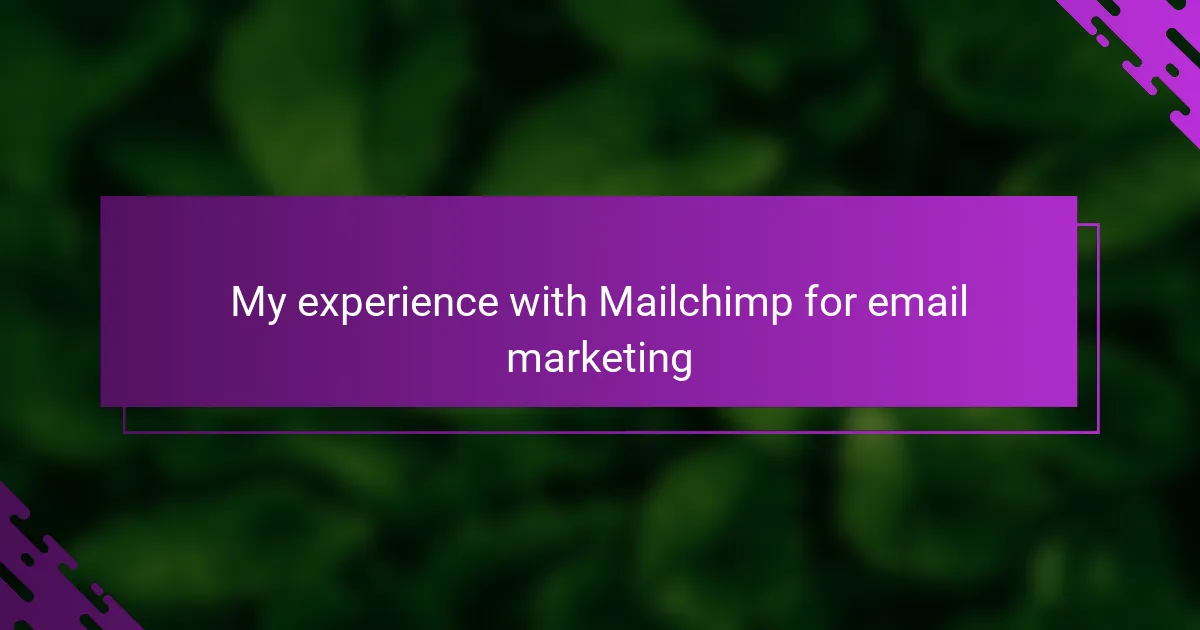Key takeaways
- Email marketing is about building relationships; understanding your audience is essential for engagement.
- Utilizing tools like Mailchimp for audience segmentation and automation can enhance personalization and save time.
- Analyzing campaign performance through detailed reports informs strategy adjustments and improves future engagement.
- Patience, continuous learning, and recognizing the emotional connection with subscribers are crucial for long-term success in email marketing.
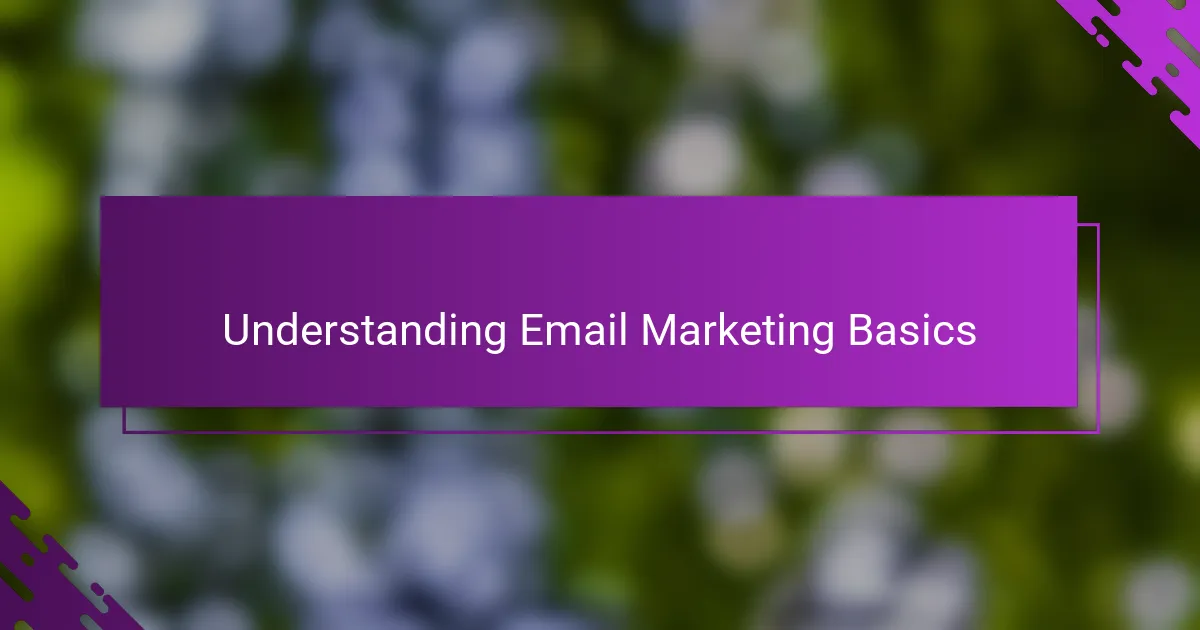
Understanding Email Marketing Basics
When I first dipped my toes into email marketing, I quickly realized it’s much more than just sending out newsletters. At its core, email marketing is about building a relationship—one where your subscribers actually look forward to what you have to say. Have you ever wondered why some emails feel personal and others just get ignored? That’s the difference good email marketing makes.
One thing that stood out to me was the importance of understanding your audience. Without knowing who you’re writing to, your message can easily get lost. I remember the frustration of crafting what I thought was a great email, only to see minimal engagement. It taught me that segmentation and relevance are key to keeping people interested.
Email marketing also taught me the power of consistency and timing. Sending emails too often can feel overwhelming, but showing up regularly helps build trust. It’s a balancing act that, when done right, turns casual readers into loyal followers. Isn’t it amazing how staying connected through simple emails can grow a community?
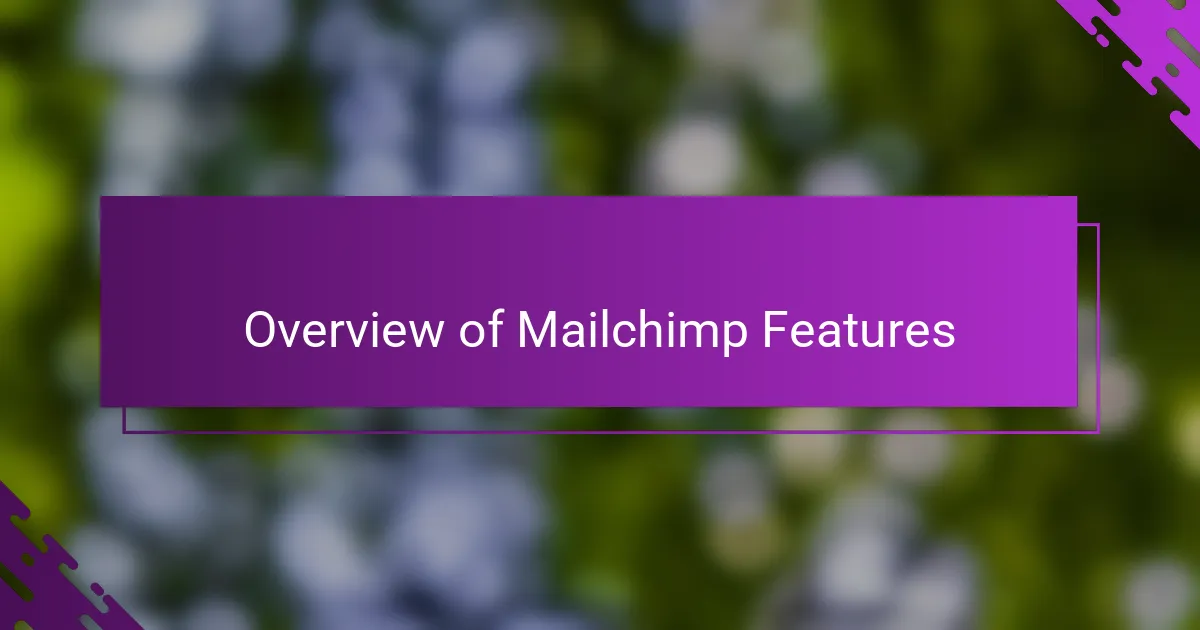
Overview of Mailchimp Features
Mailchimp’s features initially felt a bit overwhelming, but I soon discovered they’re designed to simplify many complex tasks. From customizable email templates to built-in analytics, Mailchimp provides tools that help you craft messages that look professional and track how they perform. Have you ever wished for a way to see exactly who’s opening your emails and what links they click? Mailchimp makes that possible with its detailed reports.
One feature that really resonated with me was the audience segmentation. I remember the relief when I no longer had to send the same email to everyone on my list. Instead, I could target specific groups based on their behavior and preferences, which made my campaigns feel far more personal and relevant. This approach boosted my engagement rates and taught me the value of truly knowing your audience.
Automation was another game-changer in my experience. Setting up welcome emails and follow-ups to go out automatically saved me so much time and kept my readers engaged without me having to constantly intervene. It made me realize how technology can help nurture those relationships, even when life gets busy. Have you tried automations yet? If not, I’d suggest giving them a shot—you won’t regret it.
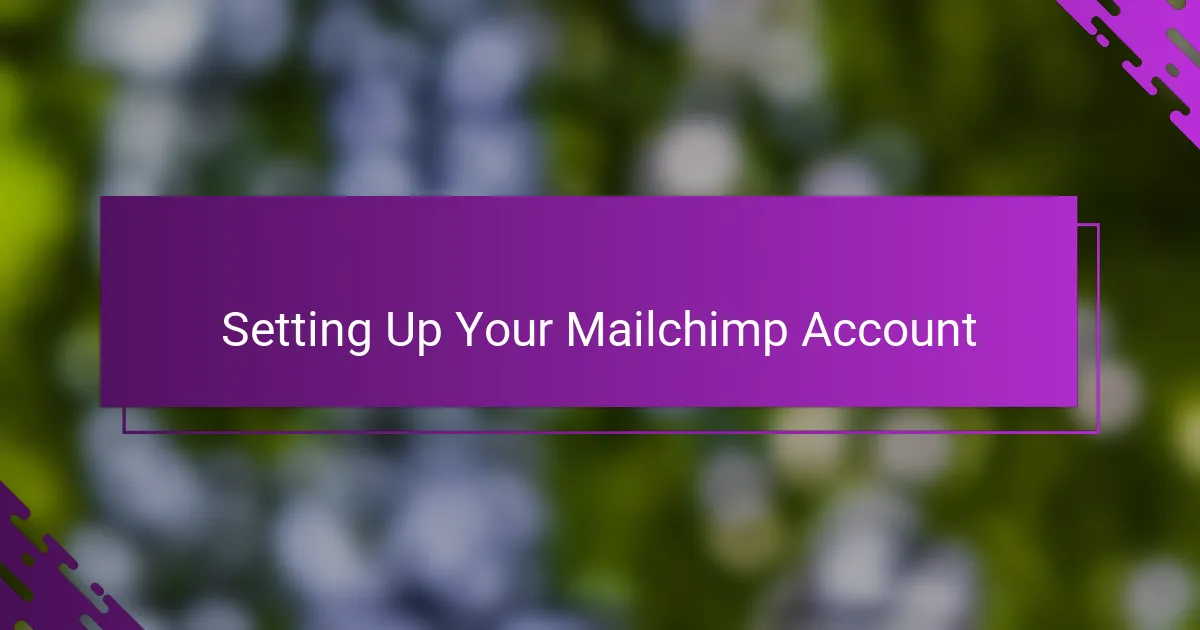
Setting Up Your Mailchimp Account
Getting started with Mailchimp was surprisingly straightforward, though I admit I felt a bit intimidated at first. Creating an account simply required my email, a username, and a password, but Mailchimp’s friendly prompts made me feel guided rather than lost. Have you ever been stuck on a signup page? With Mailchimp, that frustration quickly faded.
Once I logged in, the setup wizard was like having a helpful companion walk me through adding my audience details and connecting my website. It asked questions that made me reflect on who exactly I wanted to reach, which was a useful nudge toward defining my goals early on. I found myself appreciating how Mailchimp helped me lay a solid foundation rather than just letting me dive in blind.
Linking my personal blog to Mailchimp was another small but satisfying win. The platform offered easy integrations and clear instructions, so I could start capturing email addresses without needing technical know-how. Have you experienced the relief of finding tools that actually speak your language? For me, that moment marked the beginning of turning casual readers into a community.
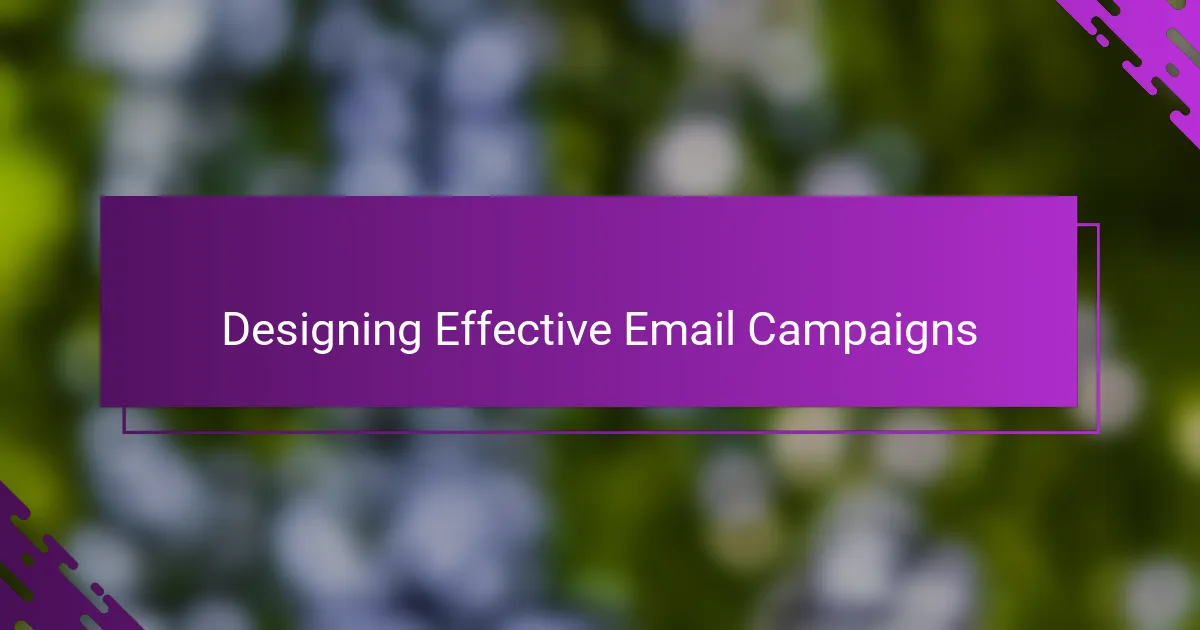
Designing Effective Email Campaigns
Designing effective email campaigns felt like both an art and a science to me. Choosing the right template was more than just picking pretty visuals—it was about creating a clean, easy-to-read layout that naturally guided my readers’ eyes to the key message. Have you ever clicked away from an email because it looked cluttered or confusing? That experience taught me how crucial good design is to keeping people engaged.
I also learned that compelling subject lines and clear call-to-actions (CTAs) are game changers. Early on, I experimented with different phrases, wondering which would spark curiosity or urgency. When I finally nailed a subject line that resonated, the open rates jumped noticeably. It made me realize how the tiniest tweaks can have a big impact.
What surprised me was how Mailchimp’s drag-and-drop editor made customizing these elements so intuitive. I wasn’t a designer, but suddenly I could tweak colors, fonts, and images to fit my blog’s vibe without feeling overwhelmed. That sense of control over the campaign’s look and feel boosted my confidence and made sending each email feel more personal—and that connection truly shows in the results.
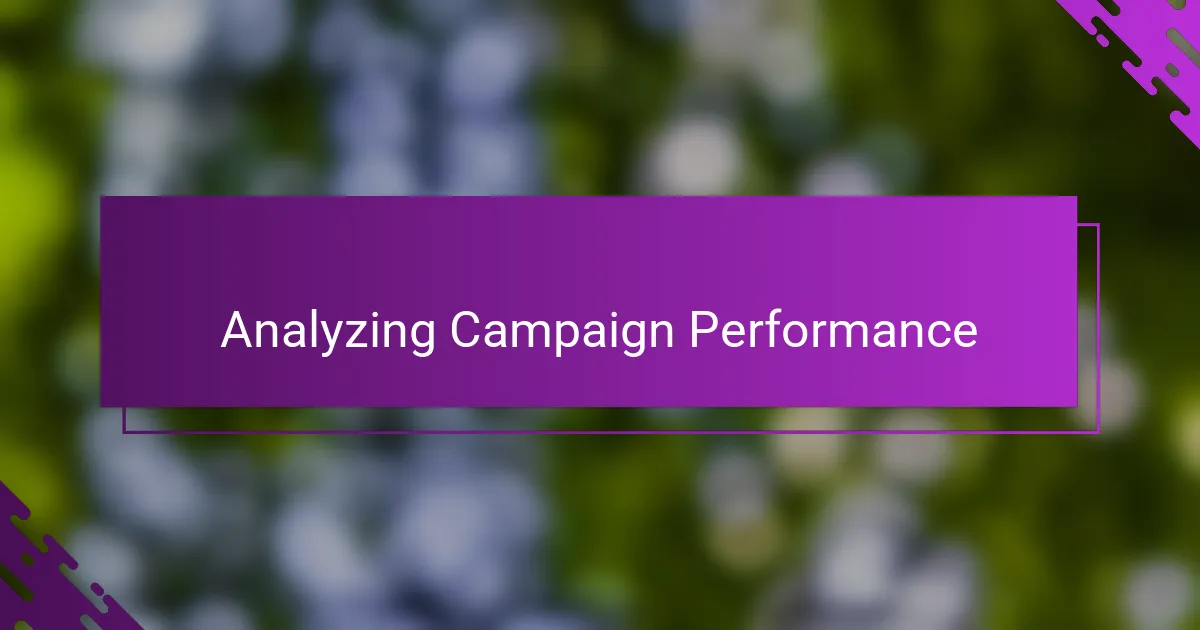
Analyzing Campaign Performance
Analyzing campaign performance on Mailchimp became one of my favorite parts of the process—it’s where all the hard work shows tangible results. I remember eagerly checking the open and click rates after sending out a newsletter, feeling a mix of excitement and nervousness, almost like waiting for feedback after sharing a personal story. Have you noticed how seeing those numbers can instantly tell you if your message truly landed?
What I found particularly insightful were the detailed reports Mailchimp offers, breaking down not just opens and clicks but also who unsubscribed or bounced. This level of detail felt like having a conversation with my audience, even if it was one-sided. It helped me tweak subject lines, refine content, and choose the best times to send emails—little adjustments that gradually made a big difference.
Sometimes, I’d look at these metrics and think, “Why did this email do better than the last?” It pushed me to experiment and learn continuously. For anyone starting out, I’d say don’t shy away from those numbers; instead, let them guide you. After all, analyzing your campaign’s performance is like getting a roadmap for clearer, more meaningful connections with your readers.
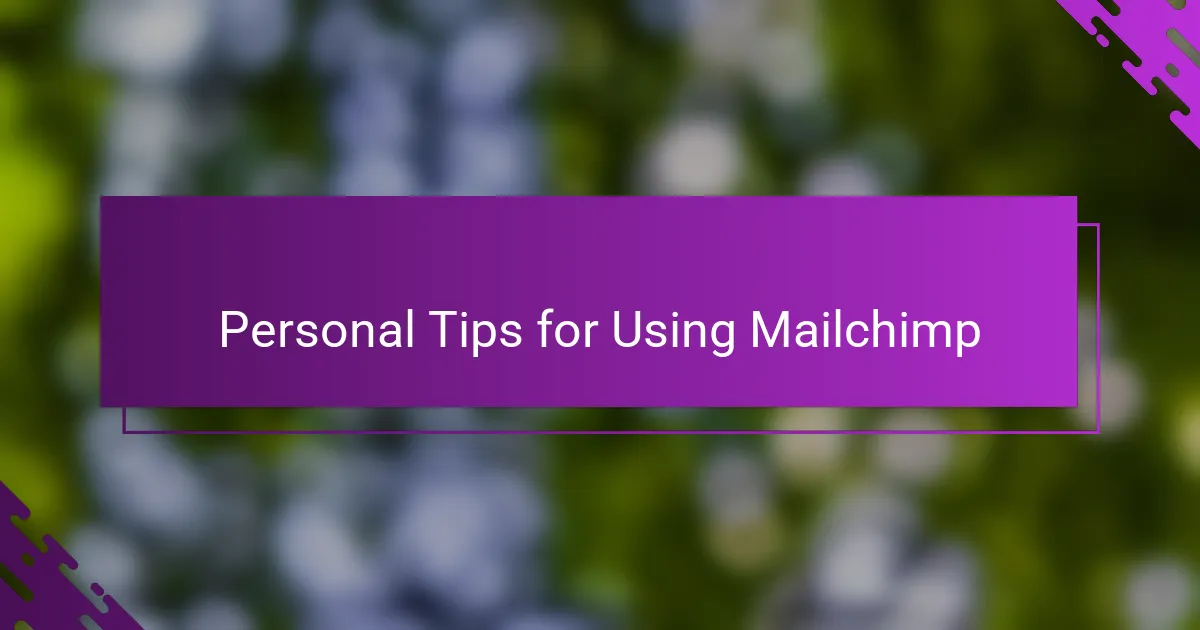
Personal Tips for Using Mailchimp
One thing I quickly learned is to keep my email lists clean and organized. It’s tempting to gather every subscriber possible, but I found that regularly removing inactive contacts not only boosted my open rates but also made me feel like I’m truly nurturing an engaged community. Have you ever paused to think about who you’re really emailing? That moment of reflection changed how I approached my campaigns.
Another tip I swear by is testing different send times. Initially, I just picked a time that felt right and stuck with it, but Mailchimp’s analytics nudged me to experiment. Sending emails when my readers were most likely to check their inboxes made a noticeable difference in engagement. It’s amazing how a simple timing tweak can make your message resonate more.
Finally, don’t underestimate the power of personalization beyond just using a name. Mailchimp’s easy-to-use merge tags helped me tailor content based on my subscribers’ preferences, which felt rewarding to set up and even more rewarding to see the results. Have you tried speaking directly to individual readers in your campaigns? It’s a small detail that truly transforms the connection.

Lessons Learned from My Experience
Looking back, one lesson that really stuck with me is the importance of patience. It’s easy to expect instant results, but email marketing, especially with Mailchimp, felt more like nurturing a garden than flipping a switch. Have you ever felt that frustration of waiting for those open rates to climb? I did too, and realizing that growth comes with consistent effort made all the difference.
Another thing I discovered was how critical it is to keep learning and adapting. Mailchimp’s detailed reports are like a mirror reflecting what works and what doesn’t, but it took me some trial and error to really interpret those signals. I remember tweaking subject lines based on one campaign’s feedback and seeing a surprising jump in engagement—it felt like decoding a secret message from my audience.
Finally, I learned not to underestimate the emotional connection behind every click or unsubscribe. Each action reminded me that real people are reading my emails, with real feelings and preferences. That awareness made me more thoughtful and authentic in my writing. Have you noticed how much more rewarding it is to write when you keep your readers’ humanity front and center? For me, that shift changed everything.
